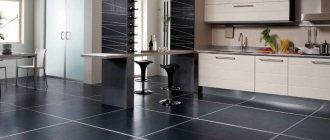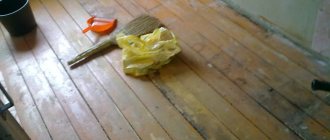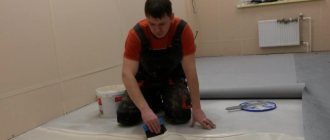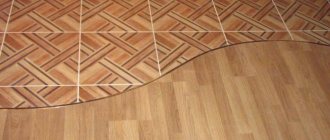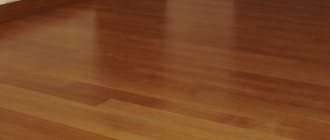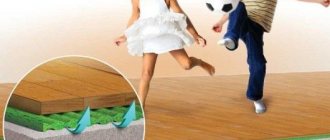Is it possible to lay new linoleum on the old one?
Is it possible to lay new linoleum on old linoleum? This is a rather controversial question and it is simply impossible to give an unambiguous answer to it. The most important criterion will be the condition of the old finishing material. The thing is that if it is all torn and wavy, then it is definitely worth throwing away. But what to do if it is in almost perfect condition and simply does not match the color of the new interior? Here it will be important to take into account several criteria:
- If the old coating only adheres to the baseboards, then it would be best to remove it.
- The old linoleum is glued on and it is simply impossible to tear it off the floor. In this case, it will be possible to lay a new layer of finishing material on the old one. However, you will first need to prepare the surface.
- If linoleum has been lying on the floor for many decades, then it must be thrown away. This is because the substrate has probably already rotted and has become more like dust. And as a result, the new coating will not last long and will soon become unusable.
Recommendations for coloring
So, you have everything you need at hand to begin the painting procedure: the right can of paint, working tools and creative enthusiasm.
Painting linoleum, as well as pre-treatment, is divided into several main stages:
- Painting tape is applied along the entire perimeter of the wall to protect it from accidental painting. By the way, with the help of this tape and or stencils you can easily feel like a designer, for example, dividing the floor into stripes or creating your own unique design.
- Dilute the paint with solvent and mix thoroughly. Pour into a tub or tray.
- Painting begins in the direction from the far wall to the door. Wait for the paint to dry completely.
- Apply a second coat. Wait until dry.
If you closely adhere to all the above recommendations, the paint on the linoleum will only need to be updated if your soul asks for new changes.
Painting linoleum is an undertaking that only at the beginning seems doomed to failure, but in the end it turns out to be an economical find for the thrifty owner. This way out of the situation will help to update the old linoleum, and with the proper design approach, it will make it a real decoration of the apartment. Overall, the game is worth the candle!
In what cases may it be necessary to lay linoleum on linoleum?
Of course, all experts, without exception, would advise laying a finishing material such as linoleum on a flat, prepared floor surface. But there are cases when a new coating of this type is laid on an old layer of linoleum. Namely:
- The old layer of linoleum was laid quite recently and is in good or even excellent condition. I just didn't like the color or pattern.
- The previously laid covering was glued and it was quite difficult to tear it off. But this is provided that its surface is in good condition.
- And it happens that the owners have no desire to stir up dirt, but they want to make repairs.
Heat-resistant paints and varnishes
She again distinguished herself when creating heat-resistant paints and varnishes. The cost of such substances is low, but the quality of the products is very high.
This coating can even be used for kitchen linoleum, since it has:
- good resistance to any thermal influence;
- optimal protection against ultraviolet rays.
After painting linoleum, you can further increase the effectiveness of the applied paint by additionally treating the surface with heat-resistant varnish.
This will add a number of properties to the coating:
- corrosion protection;
- maximum possible thermal protection;
- lasting protection against moisture and gasoline.
The operating temperature range for this coating is from -30 to +300 degrees Celsius. The applied layer of the substance dries within 3 hours at normal room temperature. It is recommended to apply at least 2-3 layers.
How to prepare a surface for laying linoleum
Due to the fact that the new coating will be laid on old linoleum, its surface requires special preparation, which must be carried out. The first step is to clear the room of all unnecessary things, or rather, take out the furniture and things, and remove the baseboards. Then, you will need to thoroughly wash the floor surface and only after that mark all those places that will require adjustment. And these are: dents, cracks, tears, bubbles and so on. Small cracks and small tears can be repaired with a sealant. They carefully fill the crack, and after the sealant has dried, they level the surface. Small dents can be removed in the same way. In order to smooth out the bubbles you will need a syringe and special glue. Inject a small amount of adhesive under the linoleum using a syringe, and then place a weight in this place. Larger damage can be repaired using patches. To do this, you will need to find material of the same thickness. After this, using a ruler, you need to carefully cut out the damaged area, and place a slightly smaller patch in its place. It must be glued, and the seams between the linoleums can be coated with welding for this type of coating.
Elimination of minor floor defects
To begin with, before the surface of the flooring is restored, it is worth carefully inspecting it for defects, in this case - scratches, dents, cracks, cuts, stains, holes and other things. And if the linoleum is well preserved, you can try to update it. When it becomes very worn out during operation, it is best to completely replace it.
- First of all, it is worth treating the surface with a soap solution. Practice shows that such a simple composition can easily get rid of most stains.
- Be extremely careful and careful while performing work. It is strictly prohibited to use undiluted ammonia, pure baking soda and other aggressive chemicals. Otherwise, you may completely ruin the linoleum. Stains, yellowed or tarnished areas may appear on its surface.
Important! Before using any of the recommended products, you should first apply it to an inconspicuous area. And if the material does not deteriorate, you can try to remove stains with it
This unwritten rule should be used always and everywhere during repair work.
- Do not delay too much in eliminating defects on the surface of linoleum. Practice shows: the earlier you start solving a problem, the easier it is. Over time, dirt can become so absorbed into the structure of the flooring that it can no longer be removed.
- Periodic cleaning and thorough cleaning of the floor covering from dust, dirt and other debris will preserve the integrity and attractive appearance of linoleum for a long time.
Important! In order for your linoleum to last for a long time, maintaining its original appearance, you should pay special attention to its cleaning. It is recommended to do wet cleaning at least twice a week with specialized household chemicals added to the water for this floor covering.
Regular wet cleaning is the key to the durability of linoleum
Which linoleum should you prefer?
In order to choose a suitable linoleum, you should pay attention to the condition and some characteristics of the old coating. So, for example, if you want to improve noise and heat insulation, then in this case you should prefer linoleum on a thick backing. But then it is worth considering that the floor surface will rise, and if there are doors that open inward, then they will need to be cut from the bottom or raised by moving the hinges. If the old finishing material is in good condition, then you can purchase linoleum without a backing. But here it is important to take into account that if there are even minor irregularities on the surface of the old linoleum, the new finishing material can very quickly tear in such places. It is best to purchase linoleum of such a width that it can completely cover the floor surface. If this is not possible, then try to keep the seams as small as possible.
Preparing linoleum
Before moving on to the actual finishing, you will need to prepare new linoleum. To do this, it should be spread on the floor surface and cut so that the edges of the old and new coating coincide. After this, it is recommended to leave it spread out for at least a day. This is necessary so that all the waves are leveled out and the surface of the coating becomes almost perfectly smooth. It is worth considering that it may take much more time to completely level the linoleum. Excessive kinks should be straightened using heavy objects. They are simply installed on the bend so that it aligns.
We fasten the linoleum using skirting boards and double-sided tape
Using skirting boards, you can fix linoleum, provided that the area of the room does not exceed 10 square meters, and the linoleum must be solid. You will need to adjust the material to size, let it rest, and then attach the baseboards so that they securely press the finishing coating. Laying linoleum with double-sided tape is somewhat more complicated and is required for rooms larger than 10 m2. To do this, the resting linoleum must be bent approximately halfway. Then stick strips of tape across the entire width of the room onto the surface of the old linoleum. A gap of no more than half a meter should be left between the strips. The last strip of double-sided tape is applied along the edge. After the tape is pasted, you need to gradually lower the new coating onto it and iron it with a special roller. When one half is secured, you should carry out exactly the same procedure with the second. At the very end you need to install the baseboards.
Useful tips for working with linoleum paints
Preliminary preparation of linoleum
Before you paint linoleum, you first need to take care of preparing the material:
- Before painting, you need to wash the old coating well and let it dry completely;
- previously waxed linoleum is treated with soda ash - 3/4 of a bucket is filled with hot water and one tea glass of soda is dissolved in it;
- after complete drying, the linoleum should be primed with oil varnish, resin urea-pharmamaldehyde varnish (MCh 26), pentaphthalic or glyphthalic varnish (as an option, “Polish varnish”);
- After the varnishes have completely dried, the floor is painted.
Advice! In the absence of varnishes, you can apply paint directly to cleaned linoleum, that is, without a primer. This somewhat degrades the quality of the coating and durability, but is quite acceptable.
Cleaning linoleum from unnecessary paint
Sometimes it happens that, due to carelessness, linoleum already laid on the floor becomes dirty with primer or paint. And not everyone knows how to remove paint from linoleum without damaging the coating? If possible, the blot should be quickly wiped off with a napkin or ordinary rag.
However, if you do not do this in time, the stain dries out and cannot be cleaned this way.
If possible, the blot should be quickly wiped off with a napkin or ordinary rag. However, if you do not do this in time, the stain dries out and cannot be cleaned this way.
There are cleaning methods for such cases:
- Mechanical method. the stain is removed due to the action of abrasive particles that can remove unnecessary blots from the linoleum covering.
- Chemical method. stains are dissolved with a special product and then effortlessly wiped off the floor.
The first method is considered more preferable, because when exposed to chemicals there is a risk of damage to the surface (the protective layer of the linoleum surface). The paint will, of course, be cleaned and rubbed off, but the original appearance may not be restored by removing the top layer along with the stain.
It is best to remove unwanted paint from linoleum quickly.
Paint, tools and techniques for painting linoleum.
Consistency is a quality that is certainly appreciated by each of us, only sometimes changes are for the better. For example, at times there may be a strong desire to change something in the apartment.
- Linoleum: composition and features
- Choosing paint and tools
- Surface preparation
- Recommendations for coloring
However, there is no extra money for expensive new things and good repairs, as always happens in such cases. Then it’s better to either minimize the changes by moving furniture or buying new curtains, or go further and afford yourself a little more.
Painted linoleum takes on a new life, it looks like new
Perhaps this does not immediately come to mind and even seems a little wild, but why not start painting linoleum, which has already become fairly worn out and lost its appearance? One can only be amazed at how much this can transform the interior of a room or apartment as a whole! But how and with what should you paint linoleum in order to achieve the highest quality result if the repair is carried out at home and by a non-professional?
With the intention of understanding this issue and receiving useful step-by-step advice, first of all, you need to consider what linoleum is and what advantages and disadvantages it has.
How to lay linoleum on linoleum using glue
If the area of the room is more than ten square meters, then special glue can and should be used to lay linoleum. And under no circumstances use double-sided tape to secure the finishing coating if the area is more than 20 m2. First, you should wait for the linoleum to cure and prepare the glue. After this, you need to lift half of the linoleum and, starting from the baseboard, apply the adhesive to the previously prepared surface. Then the new linoleum is carefully lowered and smoothed with a roller. The same procedure is carried out with the second half. Skirting boards are installed in place only after the glue has completely dried.
Features of paint selection
In fact, the question of whether it is possible to paint old linoleum is most relevant for country houses, various summer kitchens and other similar buildings. There, as you know, temperature differences are quite significant, and the load on the surface is high, since people most often walk on it wearing shoes. The strength of the surface is very important, so the paint must be of very high quality.
Important! Before starting work, you should check the coating. For finishing, only linoleum without a soft backing or material with a caked layer is suitable
If the surface is soft, the paint will crack very quickly.
Oil formulations
Budget option will save money
A few decades ago this was the only possible composition option.
This group of products is characterized by the following features:
- Low price of paint. Even though the cost has risen significantly in recent years, this option remains the most budget-friendly.
- Good adhesion of the composition to the surface. Organic-based linoleum paint adheres well and transforms the surface.
But there are many more disadvantages:
- A rather pungent odor that lasts in the room for several days. Naturally, it is undesirable to be in it during this period.
- The surface drying time is at least a day, while modern options dry in a few hours.
- Poor abrasion resistance, as a result of which the surface must be tinted at least once a year.
Alkyd-based solutions
It is best to choose special enamel for the floor - it has higher abrasion resistance characteristics
You can often come across the question, is it possible to paint linoleum with nitro paint? Due to the high properties of the composition, this type of work is not only possible, but also preferable to oil solutions. After all, paints are made using more advanced and durable polymer solvents. thanks to which the coating is more durable.
The main advantages include the following:
- A very wide range of colors, allowing you to choose the best option for any floor. The colors are very rich and vibrant, and thanks to the use of high-quality components, they remain bright for many years.
- The resulting coating is highly resistant to moisture, so alkyd paints can be used in kitchens and bathrooms.
Among the disadvantages, it is worth highlighting a rather pungent odor and low ductility of the paint layer: if the linoleum is soft, then the surface may crack.
Acrylic paints
Very high quality paint for a wide variety of substrates.
Let's figure out whether it is possible to paint linoleum with paint based on acrylic polymers. This group of compounds is characterized by high reliability and good adhesion to most materials. Linoleum is no exception, so you can paint it with acrylic paint.
The main advantages of acrylic compositions are as follows:
- High strength and wear resistance of the surface. The coating retains its properties for many years.
- Excellent surface resistance to aggressive chemical influences.
- There is virtually no smell during the work. In addition, the paint is easily washed off with water, which is also an undoubted advantage.
- The drying time of the floor is only a few hours, which allows repairs to be carried out quickly without leaving the premises.
The only downside is the high price of the composition.
Important! Linoleum is a rather complex substrate, so you should never skimp on paint. The use of low-quality composition is fraught with a short service life.
Other coating options
There are other options that are used much less frequently than those described above, although with their help you can create a very durable protective layer with your own hands:
Ultra-durable glossy paint allows you to create a durable coating that is resistant to abrasion, damage and exposure to aggressive chemicals. The instructions for using the composition are very simple, and the results are excellent. But the cost of this option is far from budget.
The coating is so durable that it is called “liquid plastic”
If you don’t know how to paint linoleum in a corridor, hallway or other damp room, you can use chlorinated rubber enamel. This composition is so durable that it is even suitable for swimming pools and terraces.
The chlorinated rubber composition has the highest protective properties.
Advantages and disadvantages
A procedure such as laying new linoleum on old has a number of positive and negative aspects. So, what are the advantages:
- Due to the fact that there is no need to remove the old coating, the finishing process will take less time.
- There will be very little dirt, due to the fact that the old linoleum will not be torn off.
- If the new linoleum is on a thick backing, the sound and heat insulation in the room will significantly increase. The floor surface will become much softer.
However, there are also disadvantages:
- There is a certain risk that a new finishing coating laid over an old one may become uneven over time.
- If before laying new linoleum, the surface was not properly prepared, then, regardless of the thickness of the substrate, all defects of the old finishing material will soon appear on the new one.
- It may take a lot of time to eliminate all defects when preparing the floor surface. This is the case if there are quite a lot of them. It can also be difficult to select a material for patches, because it must be the same thickness as the old coating.
Main contaminants and methods for their removal
Important! To ensure that soap dissolves well in water, it is recommended to grate it on a coarse grater.
- When you notice small stains of wax or paraffin, proceed as follows: cover this area with any rag and run an iron over it. The substance will appear on your scrap, and the surface of the linoleum will remain clean.
- Greasy stains and stains can be easily removed with standard dishwashing detergent. “Ferry” showed himself well. When this option does not completely eliminate the problem, proceed to radical measures. For example, treat the area with turpentine.
- If you have shoe streaks on your floors, there is a great way to deal with them. Just erase them with a standard eraser. It is especially good when fresh.
- You can get rid of traces of brilliant green on the floor with any alcohol-containing product. But remember that sometimes the procedure must be repeated three times. Don't give up if you don't succeed on the first try. Traditional methods: you can sprinkle regular baking soda on the stain and pour vinegar over it. As the baking soda dissolves, the stain should also go away.
- Paintwork that has dried without you noticing it is difficult to remove. It is recommended to immediately scrape off the paint with a knife blade, and then carefully wipe the stain with a solvent. Its effect should be immediately tested on an inconspicuous area of linoleum, and only then used on the spot.
Fresh paint is simply wiped off with a regular rag.
After removing small defects, you can begin to restore the shine and color of the floor surface.
In what cases is it necessary to remove the old layer of linoleum?
There are cases when removing old linoleum is inevitable, and there are several of them. So, in what cases do experts recommend removing old linoleum:
- You should definitely remove and throw away the finishing material purchased during the Soviet Union. The fact is that even if its surface is in fairly decent condition, the substrate material (namely, what was used in those days for its manufacture) may completely crumble by this moment. Dust and dirt will also accumulate.
- If a decent amount of dust and dirt has accumulated between the seams.
- If the old linoleum is badly damaged.
- In the case where the floor surface is uneven. Then it is recommended to remove the finishing material and level the floor.
It is possible to lay new linoleum on old one, but only in specific cases. And no builder will give you an exact answer without seeing the condition of the old coating.
Restoring the shine and color of linoleum
To give your flooring its original appearance, you should perform the following manipulations:
- remove crayons defects - we talked about this earlier;
- properly clean the floor surface with a stripper. This specialized substance will ensure reliable cleaning of linoleum from old contaminants;
- Rinse the linoleum well with water at room temperature to clean it of the alkaline composition. Afterwards you should thoroughly wipe the floor with a dry cloth. This will help you get rid of divorces;
- treat the surface with the first layer of polish. The product is applied in a thin path at a distance of two meters, and then evenly rubbed over the floor surface with a short-haired mop. It is better to perform the movements in a figure eight;
- apply a second ball of polish, but in this case already perpendicular to the first application. The procedure is identical in nature. Everything is done to ensure that the substance is evenly distributed over the linoleum, without the appearance of streaks.
Important! You should wait about half an hour between reapplying polish. Moreover, there can be from two to six such layers, depending solely on the trafficability of the site and its operational parameters.
Polished linoleum
Now you know well how to restore linoleum, or rather, its former shine and color, without the involvement of specialists.
If the linoleum is swollen
When the floor covering is swollen everywhere, it is best to carefully remove it and re-glue the linoleum, using good quality mastic.
And if the linoleum is swollen only in some places, then you can do the following:
If hot bitumen or rubber-bitumen mastic was used during installation, a puncture is made with a sharp object at the site of the swelling. Next, you should put paper on the swollen area (you can use newspaper) and iron it with a hot iron;
In case of swelling, linoleum can be repaired in another way. Use a knife to cut the coating where air accumulates and introduce solvent into the resulting hole. You can use a syringe for this. Thanks to the solvent, the mastic on which the linoleum was glued will soften. The coating should be smoothed well and a weight should be placed on top.
